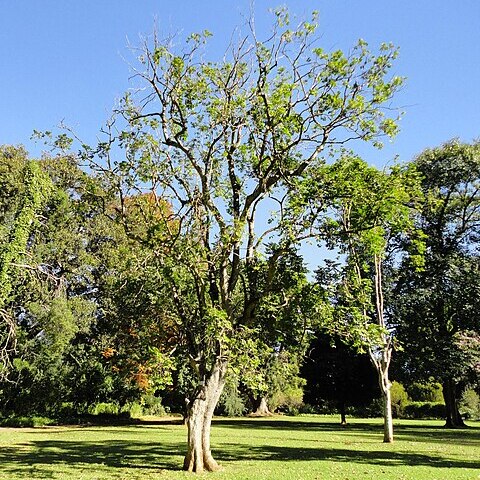Large shrub or tree up to 15 m. tall.. Bark greyish.. Branchlets ± densely short-hairy, glabrescent.. Leaf-blade (5–)10–18 cm. long, (2.8–)3.5–7 cm. wide, lanceolate or oblong, or subovate-oblong to-elliptic, shortly acuminate or obtuse, base ± oblique, cuneate, or the smaller (sometimes more highly inserted) side broadly cuneate, and the wider one almost rounded, subcoriaceous to coriaceous, firm, glabrous, or fugaciously puberulous on the midrib beneath, with circular and linear pellucid dots, somewhat shining above, entire or undulate, or when young irregularly subserrate-crenulate, with (7–)8–10 pairs of curved lateral veins, these prominent mainly beneath, reticulation rather dense and distinctly raised on both faces; petiole (7–)10–15(–18) mm. long.. Flowers greenish white, in dense axillary fascicles or glomerules on a cushion of minute puberulous bracts; pedicels rather slender, puberulous, (l–)2–4 mm. long.. Calyx-lobes shortly hairy dorsally or glabrescent, (2–)3 mm. long.. Filaments glabrous, or very slightly short-hairy.. Anthers glabrous.. Fruit ovoid-subglobular or ellipsoid, slightly 5–6-angular, splitting from above into 3–4 longitudinal valves, (1–)1.2–1.6(–1.8) cm. long, 0.9–1.2 cm. in diameter.. Fig. 16/B.
Tree, 2.3-24.4 m high. Leaves alternate, petiolate; elliptic or ovate, margins entire, sometimes serrate-crenate; stipules small. Inflorescence an axillary fascicle. Flowers bisexual; sepals 5, broadly elliptic; petals absent; staminal tube united for 0.3-0.5 mm and then divided into 10 fertile stamens and 10 alternating staminodes; filaments linear; anthers ovate; ovary superior, 1-locular with few to many ovules, 3 or 4 parietal placentas; style short; stigma capitate. Fruit yellowish orange, ellipsoid capsule, opening by 3 or 4 valves.
Leaf-lamina 5–17 x 2.8–6.5 cm., coriaceous, lanceolate or narrowly ovate, apex acuminate, acute or subobtuse, cuneate and usually oblique at the base, margins entire or undulate or when young sparsely and irregularly denticulate, glabrous on both sides or puberulous on the midrib when very young, with circular and linear pellucid dots, somewhat shining above, duller below, lateral nerves in c. 9 pairs, slightly prominent on both sides, venation laxly reticulate; petiole up to 1.3 cm. long, channelled above, puberulous or glabrous.
Staminal tube united for about 0.5 mm. and then dividing into 10 fertile stamens and 10 alternating staminodes, glabrous; filaments c. 0.8 mm. long, glabrous; anthers 0.9 x 0.6 mm., narrowly ovate, connective bluntly apiculate; staminodes up to 0.8 mm. long, oblong, villous.
Flowers greenish-white, in dense axillary fascicles on a cushion of minute, brown, membranous, ovate bracteoles with ciliolate margins; pedicels 1–2 mm. long, puberulous.
Seeds c. 10, c. 4 x 3 mm., ellipsoid with a pale smooth testa and clasped by a fleshy lobate aril hiding more than half the seed.
Sepals 5, 2–3 x 2–2.5 mm., ovate, obtuse at the apex, margins membranous, puberulous or glabrescent on the back.
Large shrub or small tree up to c. 8 m. tall; young branches puberulous, soon becoming glabrous; bark greyish.
Receptacle cupular, c. 2.5 mm. wide at the mouth, c. 1 mm. long, from puberulous to villous outside.
Fruit an angular, ellipsoid capsule splitting from above into 3–4 longitudinal valves.
Ovary ovoid, hirsute at least towards the apex; style very short; stigma capitate.


